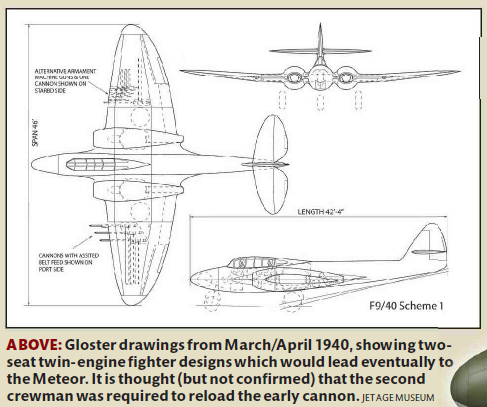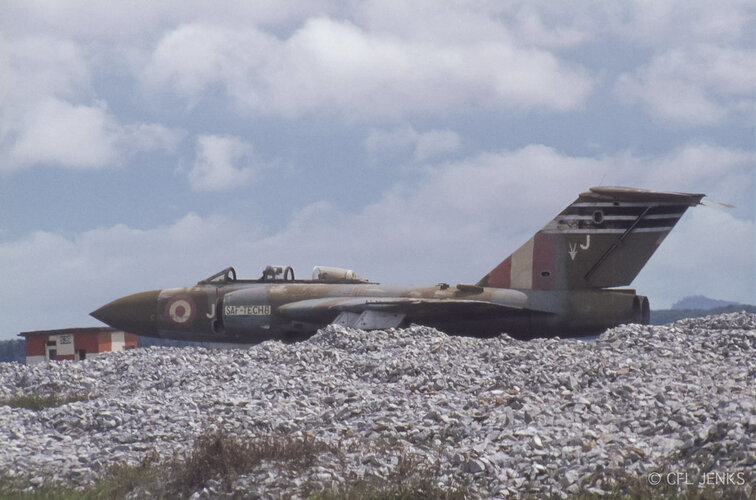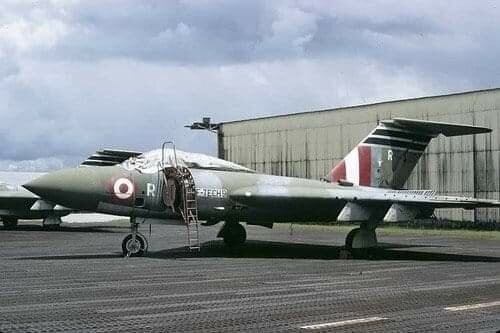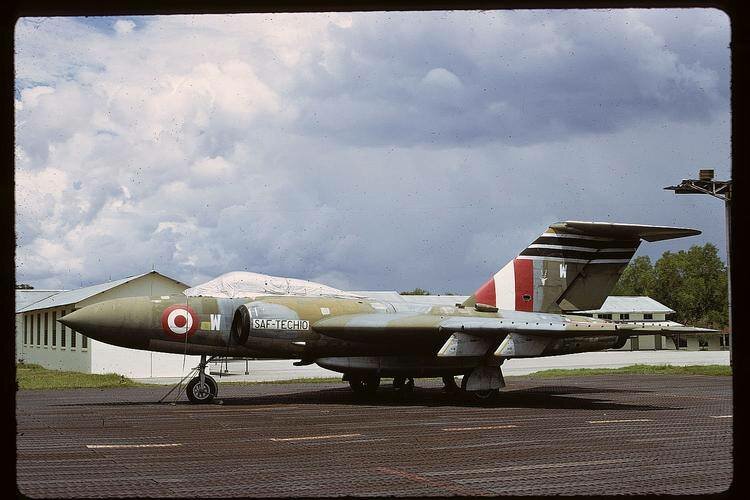Fireflash was SACLOS so inferior to Sidewinder and Falcon in most ways. It had its uses, so not superior in every way. Firestreak, however, was akin to an upscaled Falcon with addition of the proximity fuse that Falcon lacked.Was Firestreak inferior to Sidewinder and Falcon?
Was the mk1 Sparrow, being a beam rider superior to Fireflash?
The latter probably.
But the fomer?
You are using an out of date browser. It may not display this or other websites correctly.
You should upgrade or use an alternative browser.
You should upgrade or use an alternative browser.
A better Javelin....
- Thread starter zen
- Start date
red admiral
ACCESS: Top Secret
- Joined
- 16 September 2006
- Messages
- 1,468
- Reaction score
- 1,541
I think the main thing is that they are "different" rather than better or worse. It's very new technology with no previous experience and in about 10 years a number of different usable weapons were developed. It's worth remembering the other weapons that didn't make it this far (Gloster's Red Hawk anyone?)Was Firestreak inferior to Sidewinder and Falcon?
Was the mk1 Sparrow, being a beam rider superior to Fireflash?
I think a key advantage of Sidewinder over Falcon, Firestreak, Fireflash was the simplicity, which reduced size and cost, and more importantly meant a much easier integration onto aircraft. So you could put it on more aircraft, and carry more of them. There's some disadvantages compared to the other weapons, but Sidewinder was able to get significantly better with further development whilst retaining the simple integration.
- Joined
- 27 September 2006
- Messages
- 5,744
- Reaction score
- 5,633
Firestreak/Red Top like Matra 530 can be justified as essential to preserve national capability.
We then developed Taildog which unlike France's M550 Magic was not built.
France evolved Super 530 as well which with Magic and Mirage 2000 then Rafale gives it an evolutionary fighter family derived from Mirage III.
The UK treads a different path of jerks and borrows. Phantom with Sidewinder and Sparrow/Skyflash then Tornado ADV.
Typhoon gets ASRAAM and AMRAAM then Meteor.
So despite different paths we and France are still in the game.
We then developed Taildog which unlike France's M550 Magic was not built.
France evolved Super 530 as well which with Magic and Mirage 2000 then Rafale gives it an evolutionary fighter family derived from Mirage III.
The UK treads a different path of jerks and borrows. Phantom with Sidewinder and Sparrow/Skyflash then Tornado ADV.
Typhoon gets ASRAAM and AMRAAM then Meteor.
So despite different paths we and France are still in the game.
T. A. Gardner
ACCESS: Top Secret
- Joined
- 18 February 2021
- Messages
- 882
- Reaction score
- 1,516
All three left US service during 1988.When did Falcon and Genie equipped F106 leave US service?
- Joined
- 27 September 2006
- Messages
- 5,744
- Reaction score
- 5,633
Thank you. So good value for money compared with Lightning.All three left US service during 1988.
T. A. Gardner
ACCESS: Top Secret
- Joined
- 18 February 2021
- Messages
- 882
- Reaction score
- 1,516
The 106 was entirely relegated to the Air National Guard from about the late 70's or so as they were the portion of the air force handling national air defense fighter aircraft. In a way, that meant that often the pilots were very high hour ones who had resigned from active service but stayed on in the reserve and guard.Thank you. So good value for money compared with Lightning.
Also, many 106's got the Genie removed and replaced with a 20mm gatling gun late in their service life. The 106 after being withdrawn continued on as target drones until expended.
red admiral
ACCESS: Top Secret
- Joined
- 16 September 2006
- Messages
- 1,468
- Reaction score
- 1,541
Actually F-106 and Lightning are very similar in many ways; basically the same role, enter service at the same time, similar service history in air defence role, similar time leaving service.Thank you. So good value for money compared with Lightning.
F-106 also retained the same missile fit through life and didn't have any significant upgrades. It was pretty limited by early design choices too e.g. weapon bay arrangement, single use compressed air actuation etc.
But no one complains about lack of F-106 exports
Rule of cool
ACCESS: Secret
- Joined
- 16 January 2024
- Messages
- 498
- Reaction score
- 640
But no one complains about lack of F-106 exports.
I think this is because the US doesn't need massive wins every time, it can 'carry' a medium sized fighter fleet well enough whereas the likes of Britain gets a big boost from exports.
Worse rate of climb, though with SAGE the warning distance was enormous and gave plenty of time to get up to altitude.Actually F-106 and Lightning are very similar in many ways; basically the same role, enter service at the same time, similar service history in air defence role, similar time leaving service.
F-106 also retained the same missile fit through life and didn't have any significant upgrades. It was pretty limited by early design choices too e.g. weapon bay arrangement, single use compressed air actuation etc.
But no one complains about lack of F-106 exports. This didn't make it any better or worse.
Roland Beaumont was impressed by the Hughes Fire Control System.
Much less warning time for the UK.
Last edited:
T. A. Gardner
ACCESS: Top Secret
- Joined
- 18 February 2021
- Messages
- 882
- Reaction score
- 1,516
The difference is the 106 was very much an all-weather interceptor while the Lightning was very limited outside being a basic daylight interceptor (not that there weren't attempts to improve its all-weather capacity). The Falcon did receive several major upgrades, mostly due to improvements in Sidewinder. One of the more significant ones was nitrogen cooling of the seeker on the IR versions.Actually F-106 and Lightning are very similar in many ways; basically the same role, enter service at the same time, similar service history in air defence role, similar time leaving service.
F-106 also retained the same missile fit through life and didn't have any significant upgrades. It was pretty limited by early design choices too e.g. weapon bay arrangement, single use compressed air actuation etc.
But no one complains about lack of F-106 exports. This didn't make it any better or worse.
The lack of exports is probably due more to it being built in relatively small numbers and being so specialized as an interceptor. The F-102 got a few exports but really didn't see much foreign service either.
T. A. Gardner
ACCESS: Top Secret
- Joined
- 18 February 2021
- Messages
- 882
- Reaction score
- 1,516
The Hughes MA 1 was a huge improvement over the previous MG 1 - 12 series and no comparison to the even earlier E 1-9 series systems of the 50's.Worse rate of climb, though with SAGE the warning distance was enormous and gave plenty of time tl get up to altitude.
Roland Beaumont was impressed by the Hughes Fire Control System.
Much less warning time for the UK.
red admiral
ACCESS: Top Secret
- Joined
- 16 September 2006
- Messages
- 1,468
- Reaction score
- 1,541
I think just just about everything at this point had worse rate of climb than Lightning, apart from maybe Mirage IIIE? Hence the rockets in F.155T. You could argue this is over-optimising for a single mission type, or focusing on what is important. Maybe to get more warning time (and have a slower climbing interceptor) the UK should have put radars in the Netherlands and Denmark and laid some wires as planned for the contemporary Violet Friend ABM system.
The F-106 avionics look amazing for the era when you read into them. The development history in Barbier's F-106 book was a good read.
The F-106 avionics look amazing for the era when you read into them. The development history in Barbier's F-106 book was a good read.
Or maybe the UK should have kept up the ACI effort from WWII.
Maybe the conversion of the Freightstar to AWACS should have been funded.
Or the '55 BEWARE.
And then put a standing patrol up towards the threat and thus extend warning times.
Maybe the conversion of the Freightstar to AWACS should have been funded.
Or the '55 BEWARE.
And then put a standing patrol up towards the threat and thus extend warning times.
red admiral
ACCESS: Top Secret
- Joined
- 16 September 2006
- Messages
- 1,468
- Reaction score
- 1,541
Or stuck Type 984 on a big barge* anchored on Dogger Bank. I'm surprised this didn't come up actually.And then put a standing patrol up towards the threat and thus extend warning times.
*Or maybe that Majestic Class conversion with SeaSlugs
More like site Type 85 on a Dutch Island.....Or stuck Type 984 on a big barge* anchored on Dogger Bank. I'm surprised this didn't come up actually.
*Or maybe that Majestic Class conversion with SeaSlugs
Or If I was being prescient, I'd have reclaimed Heligo Island back from Germany in '45 and then put such radar there.
And another say on Jylland in Denmark.
And another in Norway
And another at Gibraltar.
T. A. Gardner
ACCESS: Top Secret
- Joined
- 18 February 2021
- Messages
- 882
- Reaction score
- 1,516
Some idea of the viability of the US fire control systems for fighters of the period can be gotten from 'The Battle of Palmdale.' This involved an F6F-5K drone that went astray being intercepted to be shot down by USAF F-89D fighters over southern California.
The F-89D's had the E-9 (updated as the MG-3) fire control system and were armed with hundreds of 2.75" FFAR rockets. Two were sent to take care of the wandering drone.
For whatever reason, neither found on intercept that their E-9 fire control system was actually working and they had no back up sighting reticle or whatever to aim on the drone with. Both crews however were determined to shoot the F6F down as it flew in a fixed curve ahead of them. The two F-89D fired a total of nearly 200 FFAR's at the drone failing to hit it a single time...
They did manage to hit stuff on the ground, start some brush fires, and the like, but didn't shoot the F6F down. It eventually ran out of fuel and crashed in the desert in S. California. So...
They just needed a bigger rocket...
The F-89D's had the E-9 (updated as the MG-3) fire control system and were armed with hundreds of 2.75" FFAR rockets. Two were sent to take care of the wandering drone.
For whatever reason, neither found on intercept that their E-9 fire control system was actually working and they had no back up sighting reticle or whatever to aim on the drone with. Both crews however were determined to shoot the F6F down as it flew in a fixed curve ahead of them. The two F-89D fired a total of nearly 200 FFAR's at the drone failing to hit it a single time...
They did manage to hit stuff on the ground, start some brush fires, and the like, but didn't shoot the F6F down. It eventually ran out of fuel and crashed in the desert in S. California. So...
They just needed a bigger rocket...
Last edited:
T. A. Gardner
ACCESS: Top Secret
- Joined
- 18 February 2021
- Messages
- 882
- Reaction score
- 1,516
I have the advantage that the Raytheon (ex-Hughes) plant where the fire controls were made is 150 miles from my house and still turning out weapons for the US military...I think just just about everything at this point had worse rate of climb than Lightning, apart from maybe Mirage IIIE? Hence the rockets in F.155T. You could argue this is over-optimising for a single mission type, or focusing on what is important. Maybe to get more warning time (and have a slower climbing interceptor) the UK should have put radars in the Netherlands and Denmark and laid some wires as planned for the contemporary Violet Friend ABM system.
The F-106 avionics look amazing for the era when you read into them. The development history in Barbier's F-106 book was a good read.
T. A. Gardner
ACCESS: Top Secret
- Joined
- 18 February 2021
- Messages
- 882
- Reaction score
- 1,516
Oh, some contemporaries that could climb with a Lightning:I think just just about everything at this point had worse rate of climb than Lightning, apart from maybe Mirage IIIE? Hence the rockets in F.155T. You could argue this is over-optimising for a single mission type, or focusing on what is important. Maybe to get more warning time (and have a slower climbing interceptor) the UK should have put radars in the Netherlands and Denmark and laid some wires as planned for the contemporary Violet Friend ABM system.
The F-106 avionics look amazing for the era when you read into them. The development history in Barbier's F-106 book was a good read.
The F4D Skyray... It could make just shy of 50,000 feet from a standing start in two-and-a-half minutes climbing at a 70 degree angle, and that's doing it subsonic!
The F-104, particularly if you accelerated to above Mach before starting your climb. The climb rate was somewhere between about 50,000 fpm to 25,000 fpm depending on speed and altitude when entering the climb.
Whaaat ? can you point me to a link ? SeaSlug was a hugely cumbersome system, but aircraft carriers at least have plenty of internal space.*Or maybe that Majestic Class conversion with SeaSlugs
- Joined
- 27 September 2006
- Messages
- 5,744
- Reaction score
- 5,633
Whaaat ? can you point me to a link ? SeaSlug was a hugely cumbersome system, but aircraft carriers at least have plenty of internal space.
Thank you. Now that's quite an interesting idea: kinda turning all those Colossus / Majestic into upscaled Jeanne d'Arc / Doria / Moskva ? That is, an "air group" part big naval SAMs, part helicopters ?
Rule of cool
ACCESS: Secret
- Joined
- 16 January 2024
- Messages
- 498
- Reaction score
- 640
Not sure about the statement saying the second crewman could be there to reload the cannon......
I think Beaufighter Night Fighters with early 60 round drum magazine cannon were reloaded in flight by the radar operator. The adoption of belt feeding reduced or even eliminated this requirement.
I think Beaufighter Night Fighters with early 60 round drum magazine cannon were reloaded in flight by the radar operator. The adoption of belt feeding reduced or even eliminated this requirement.
Yeah but these cannon are in the wings.....
Rule of cool
ACCESS: Secret
- Joined
- 16 January 2024
- Messages
- 498
- Reaction score
- 640
Yeah but these cannon are in the wings.....
Then the 2nd crewman better cling on!
Found one of the piccies here
Not sure about the statement saying the second crewman could be there to reload the cannon......
View attachment 719400
Scheme 2 was very similar to this but with the engines slightly further out and the three wing cannon on each side between the fusleage and the engine. There were an additional two cannon in the fuselage making eight in total. I think the argument for eight cannon was the higher speeds for the jets meant less time for an actual hit, similar to the argument form going from four machine guns to eight.
- Joined
- 2 January 2006
- Messages
- 976
- Reaction score
- 1,653
Singapore Air Force Javelin (maintenance airframe) ...
View: https://www.flickr.com/photos/112125468@N06/46580634595
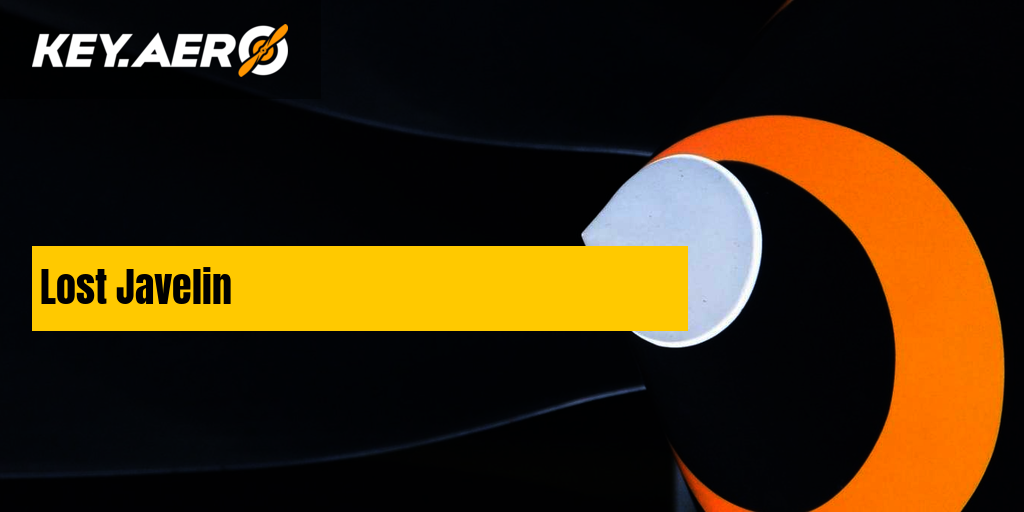
 www.key.aero
www.key.aero
Lost Javelin
Anyone know if this still exists- left in Zambia in the 60's XH890 post landing accident
Attachments
CV12Hornet
ACCESS: Secret
- Joined
- 8 January 2021
- Messages
- 393
- Reaction score
- 864
The Hunter exists and is much cheaper and better at the job.Can the javelin get a new life as a ground attack /strike platform
F.L.
ACCESS: Top Secret
What's sort of sad is had the whole Missileer concept come along earlier or had the RAF understood it. Then the Javelin is a platform that might have been converted to that role. With more focus on endurance and load carrying.
Wasn't it the only Fighter in the UK with a 35" diameter dish?
Wasn't it the only Fighter in the UK with a 35" diameter dish?
Main problem with the Javelin as a Missileer + Red Dean / Red Hebe: drag, drag, and more drag. The missiles were enormous (and draggy) and so was the Javelin.
A pity, because the combination might have been an intriguing alternative to F.155T: starting from Thin Wing Javelin last iterations: such as the P.376 with Olympus.
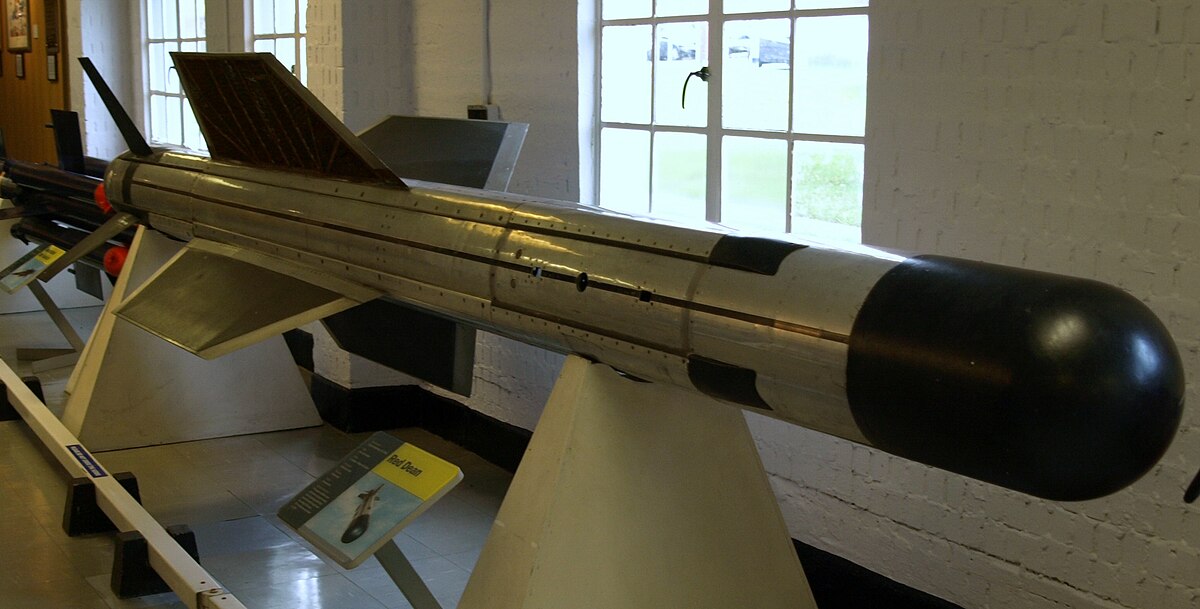
 en.wikipedia.org
en.wikipedia.org
 en.wikipedia.org
en.wikipedia.org
What is really fascinating is to compare Thin Wing Javelin with Arrow and Fairey F.155T winner. Also by 1956 the RAF hesitated between the three, drawing comparisons between them.
The Arrow was not good enough for F.155T but still buried any TW Javelin, even P.376. Main issue was that Red Dean / Red Hebe would not fit inside the weapon bay.
Another interesting aspect was that the Arrow's Sparrow II were ARH - active radar homing... just like Red Dean and Red Hebe. This amounted to building an AMRAAM with 1950's technology - and that was hopeless.
A pity, because the combination might have been an intriguing alternative to F.155T: starting from Thin Wing Javelin last iterations: such as the P.376 with Olympus.
Red Dean - Wikipedia
Red Hebe - Wikipedia
What is really fascinating is to compare Thin Wing Javelin with Arrow and Fairey F.155T winner. Also by 1956 the RAF hesitated between the three, drawing comparisons between them.
The Arrow was not good enough for F.155T but still buried any TW Javelin, even P.376. Main issue was that Red Dean / Red Hebe would not fit inside the weapon bay.
Another interesting aspect was that the Arrow's Sparrow II were ARH - active radar homing... just like Red Dean and Red Hebe. This amounted to building an AMRAAM with 1950's technology - and that was hopeless.
Last edited:
red admiral
ACCESS: Top Secret
- Joined
- 16 September 2006
- Messages
- 1,468
- Reaction score
- 1,541
AAM-N-10 Eagle Range > 100nmMain problem with the Javelin as a Missileer + Red Dean / Red Hebe: drag, drag, and more drag. The missiles were enormous (and draggy) and so was the Javelin.
Red Dean Range < 5nm
So a Javelin missileer doesn't really work unless there's a giant leap in UK missile performance, which doesn't even happen conceptually until the likes of air-launched Sea Dart in the mid 70s, or in hardware terms then Meteor today. It's really difficult to see how to bring this forwards besides buying into US weapons e.g. Eagle with a UK seeker
When Javelin was being conceived the main armament option was a 4.5" gun
No it could have been done, based on Thunderbird mkII or Bloodhound technologies.
No that doesn't mean trying to mount Thunderbird from a pylon, rather it means trying to squeeze the guidance package into a large AAM.
Or just buying in the Eagle AAM, which looks like the strongest case. Until Sea Dart.....though earlier A5 seeker technology is a possibility.
But.....this probably favours the larger V-Bomber or converted Civilian Airliner concept better than the Javelin.
No that doesn't mean trying to mount Thunderbird from a pylon, rather it means trying to squeeze the guidance package into a large AAM.
Or just buying in the Eagle AAM, which looks like the strongest case. Until Sea Dart.....though earlier A5 seeker technology is a possibility.
But.....this probably favours the larger V-Bomber or converted Civilian Airliner concept better than the Javelin.
Similar threads
-
-
Gloster's Heavy Fighter/Bomber P.293
- Started by zen
- Replies: 4
-
-
-

